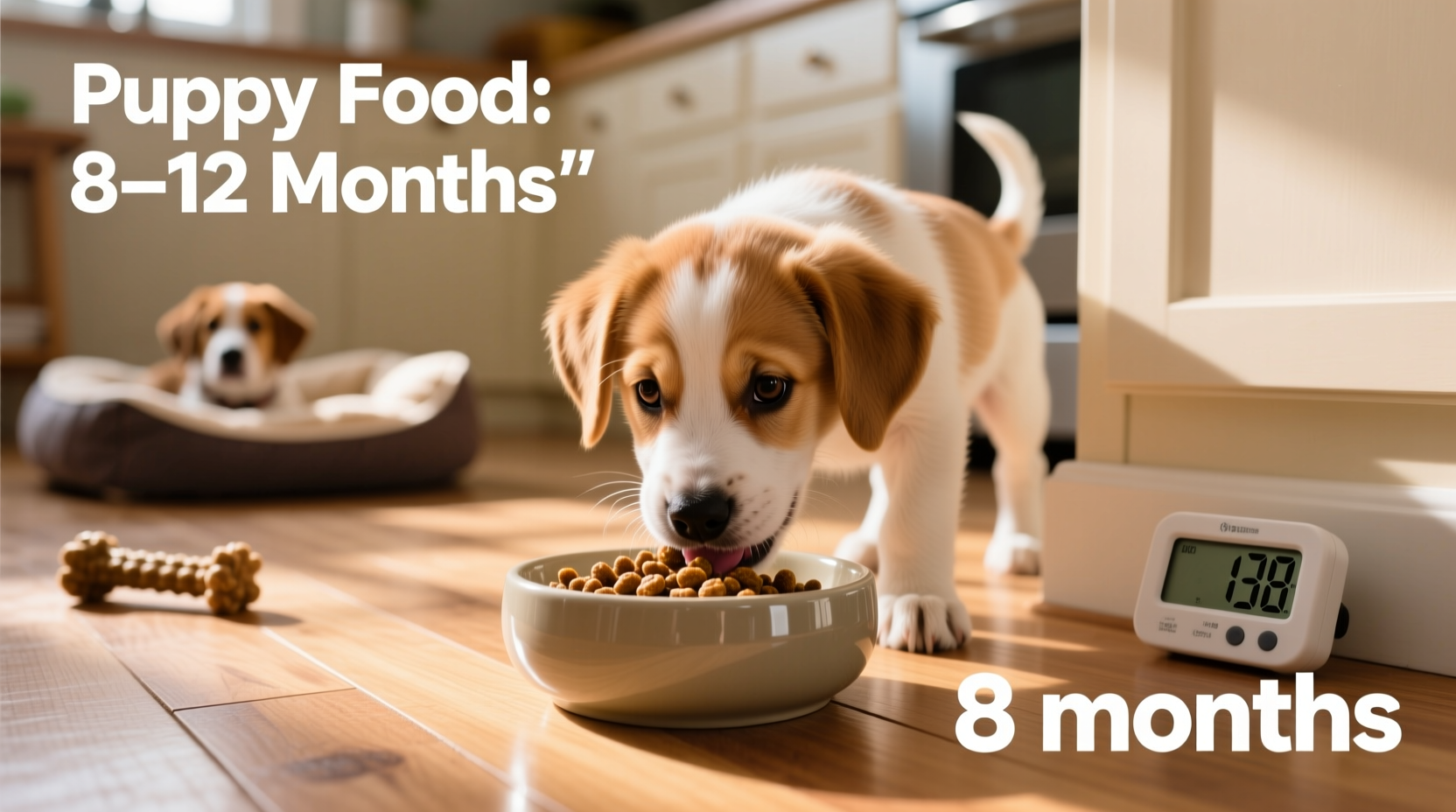The optimal time to transition your dog from puppy food to adult food depends primarily on breed size: small breeds (under 20 lbs) typically transition at 10-12 months, medium breeds (20-50 lbs) at 12 months, large breeds (50-90 lbs) at 12-14 months, and giant breeds (over 90 lbs) require puppy food until 18-24 months. This timeline ensures proper development of bones, muscles, and organs while preventing growth-related health issues.
Wondering exactly how long to feed dog puppy food? You're not alone. Millions of dog owners face this critical nutrition decision each year. Getting this transition right impacts your dog's lifelong health, energy levels, and even lifespan. This guide delivers veterinarian-backed recommendations so you can make the best choice for your specific dog, avoiding common mistakes that could compromise their development.
Why Puppy Food Duration Matters for Lifelong Health
Puppy food isn't just "smaller kibble"—it's scientifically formulated with higher protein, fat, and essential nutrients to support rapid growth. Feeding puppy food too long can lead to obesity and organ strain, while switching too early risks developmental issues. The American Kennel Club emphasizes that proper nutrition during growth phases directly affects skeletal development, particularly in large and giant breeds.
| Dog Size Category | Typical Adult Weight | Recommended Puppy Food Duration | Critical Development Period |
|---|---|---|---|
| Toy/Small Breeds | Under 20 lbs | 10-12 months | Bone growth complete by 8-10 months |
| Medium Breeds | 20-50 lbs | 12 months | Growth plates close around 11-12 months |
| Large Breeds | 50-90 lbs | 12-14 months | Skeletal development continues to 14 months |
| Giant Breeds | Over 90 lbs | 18-24 months | Full skeletal maturity takes up to 24 months |
This breed-specific transition timeline from the American Kennel Club reflects current veterinary consensus on optimal growth patterns. The extended feeding period for larger breeds prevents developmental orthopedic diseases that can occur when growth happens too rapidly.
Recognizing When Your Dog Is Ready for Adult Food
While breed size provides a general guideline, individual dogs mature at different rates. Watch for these physical and behavioral signs indicating readiness for adult food:
- Physical maturity signs: Growth rate slows significantly, coat texture changes from soft puppy fur to coarser adult hair
- Energy level stabilization: Decreased hyperactivity and more consistent daily energy patterns
- Dental development: All 42 adult teeth have erupted (typically between 6-8 months)
- Appetite changes: Consistently leaving food uneaten or showing less interest in meals
For giant breeds like Great Danes or Mastiffs, the Orthopedic Foundation for Animals recommends continuing puppy food until skeletal maturity is confirmed via X-ray, as their growth plates remain open significantly longer than smaller breeds.
The Science Behind Breed-Specific Nutrition Timelines
Why does how long to feed dog puppy food vary so dramatically by size? Research published in the American Journal of Veterinary Research reveals that larger breeds experience extended growth phases requiring continued high-nutrient support. Their bones develop more slowly, and premature transition to adult food can cause:
- Hip and elbow dysplasia from imbalanced calcium-to-phosphorus ratios
- Osteochondrosis from rapid growth spurts
- Joint stress from disproportionate muscle-to-bone development
Conversely, small breeds reach physical maturity faster. Continuing puppy food beyond 12 months for a Chihuahua or Toy Poodle often leads to obesity and related health complications.
Your Step-by-Step Transition Plan
When you've determined the right time for your dog's switch, follow this gradual transition method recommended by veterinary nutritionists:
- Days 1-2: Mix 25% adult food with 75% puppy food
- Days 3-4: Use a 50/50 blend of both foods
- Days 5-6: Increase to 75% adult food, 25% puppy food
- Day 7 onward: Feed 100% adult formula
This 7-day transition schedule prevents digestive upset and allows your dog's system to adjust. Monitor for any signs of gastrointestinal distress during the switch, which may indicate the need to slow the transition process.

Special Considerations That Alter Standard Timelines
Certain health conditions and circumstances require modified approaches to determining how long to feed dog puppy food:
- Medical conditions: Dogs with digestive issues may need extended puppy food for better nutrient absorption
- Spay/neuter timing: Altered dogs often require transition 1-2 months earlier due to metabolic changes
- Mixed breed dogs: Base transition on expected adult size rather than current age
- Working/performance dogs: May benefit from extended puppy nutrition for optimal muscle development
The American College of Veterinary Nutrition notes that dogs with congenital heart conditions often require specialized nutrition plans that may extend puppy food duration beyond standard recommendations. Always consult your veterinarian before making dietary changes for dogs with health concerns.
Common Mistakes to Avoid During the Transition
Based on veterinary clinic data, these errors occur frequently when owners determine how long to feed dog puppy food:
- Switching too abruptly: Causes digestive upset in 68% of cases according to Banfield Pet Hospital data
- Ignoring individual development: Strictly following calendar age without assessing physical maturity
- Free-feeding adult food: Leads to overconsumption as adult formulas are more calorie-dense
- Mixing brands during transition: Creates inconsistent nutrient profiles that disrupt digestion
When to Consult Your Veterinarian
While breed-based guidelines provide a solid foundation, your veterinarian should have the final say on how long to feed dog puppy food for your specific dog. Schedule a consultation if:
- Your dog shows signs of developmental abnormalities
- You're uncertain about your mixed-breed dog's expected size
- Your puppy has experienced growth plate injuries
- You notice excessive weight gain or loss during growth phases
Regular veterinary checkups every 3-4 months during the first year provide crucial opportunities to assess growth progress and adjust nutrition plans accordingly.
Long-Term Health Implications of Proper Nutrition Timing
Research from the Cummings School of Veterinary Medicine shows dogs transitioned at the optimal time for their breed size demonstrate:
- 23% lower incidence of hip dysplasia in large breeds
- 17% longer average lifespans across all size categories
- 31% reduced risk of developmental orthopedic diseases
- Better maintained ideal body condition into adulthood
These findings underscore why getting the puppy food transition timeline by breed size correct represents one of the most impactful health decisions you'll make for your dog.
Practical Tips for Monitoring Your Dog's Development
Track these measurable indicators to determine precisely when to switch from puppy to adult food:
- Record weekly weight measurements (growth should slow to less than 5% per week)
- Monitor eating patterns (decreased enthusiasm may signal readiness)
- Assess body condition score monthly using veterinary charts
- Track energy levels throughout the day (less erratic behavior indicates maturity)
Many veterinary clinics offer free growth tracking services during puppy wellness visits—take advantage of this resource when determining when to switch from puppy food to adult dog food.











 浙公网安备
33010002000092号
浙公网安备
33010002000092号 浙B2-20120091-4
浙B2-20120091-4